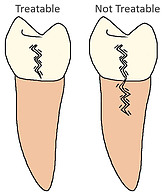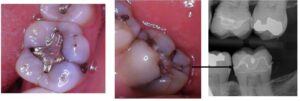Crowns are among the more costly dental treatments. You might be wondering if you really need one. I hope to offer insight on this question. Unfortunately, it’s not always so cut and dry.
For most people, maintaining healthy teeth for a lifetime usually requires some proactive investment. Otherwise, you risk spending more money reacting to a problem for a worse outcome. An ounce of prevention is worth a pound of cure! But, we also want to be sure that we are making wise investments.
Is a Crown a Wise Investment for You?
 Recommending a crown is a subjective call. The threshold for recommending a crown can be different from one dentist to another. When we recommend a crown, it is usually because your tooth is vulnerable to infection or fracture. These vulnerabilities come from cracks, broken cusps, or very large fillings that weaken your tooth.
Recommending a crown is a subjective call. The threshold for recommending a crown can be different from one dentist to another. When we recommend a crown, it is usually because your tooth is vulnerable to infection or fracture. These vulnerabilities come from cracks, broken cusps, or very large fillings that weaken your tooth.
Protection from Future Infection
Mother nature put enamel over our teeth for a reason. It serves as a suit of armor for the harsh, acidic, bacterial-filled oral environment. But, sometimes old fillings leak, cracks develop, or a cusp breaks off. These breaches in the protective outer layer of the tooth allow opportunistic bacteria to more easily work their way inside.

Once the bacteria make it past the enamel layer of the tooth, they’ll have a much easier time reaching the pulp. Over time, the pulp’s defenses can become overwhelmed and allow it to succumb to infection. Low-level pulp infections are often not symptomatic.
But, when the infection gets severe enough, it can cause a horrible toothache. The only available remedies for a pulp infection are a root canal or tooth removal.
I think it’s safe to say that most of us would prefer to avoid the pulp infection in the first place!
To reduce the chance of that happening, we will often recommend a crown. The crown will replace that protective outer layer of enamel and seal the tooth off so that bacteria can’t find their way in so easily.
To be clear, it’s still possible to develop a pulp infection even after a crown is placed, but it’s better to put the odds in your favor.
Protection Against Crack Propagation
When a crack develops, it may start to migrate down the tooth. If it gets well into the root, the tooth is no longer fixable. It must be removed. That’s because there is no way to seal off the crack. In this case, the infection is not in the pulp, but it’s harbored between the tooth and the gums. A crown can prevent additional propagation of a crack.

Protection Against Fracture
The number one reason that crowns are recommended is to prevent a tooth fracture. Both large fillings and cracks can weaken a tooth and make it subject to fracture.

With Tooth Fracture, You Never Know What You’re Gonna Get!
If you don’t get your crown done in time and your tooth fractures, you’re at the mercy of the dental lottery. Sometimes your tooth will fracture in such a way that you can still repair your tooth with a crown.
Other times, you may need additional procedures like a root canal, or crown lengthening. And, other times, the tooth is not repairable and must be removed.
Can You Count on a Warning Sign?

Now that you know the potential outcomes of leaving a structurally vulnerable tooth untreated, you might wonder if you can just wait and see if a problem develops.
The trouble is, the timing of the complications I discussed is pretty much impossible to predict. While we can detect risk factors for tooth fracture, we can’t tell when you’re tooth is on the brink of fracture.
We might get some sense of the extent of the crack in your tooth, but we can’t determine when the crack will propagate into dangerous territory. The same holds true for pulp infections.
Sometimes mild symptoms arise before catastrophe strikes – like pain on chewing or cold sensitivity. But, more often they won’t. So, you can’t rely on warning symptoms to let you know it’s time. Worse yet, if these symptoms do arise, it may already be too late to avoid a root canal.
Timing is Tricky – A Tale of Two Teeth

Let’s go through a couple of examples. The tooth pictured on the left has a stained crack on its cheek-facing side. But it doesn’t look terribly alarming. In fact, it didn’t hit my threshold to recommend a crown.
Conversely, the tooth photo on the right looks a lot worse. It had many dark stained cracks. I did recommend a crown on that tooth. The patient complied and all has been well with that tooth for many years since.
It turns out that I was wrong about the tooth on the left. That tooth ended up developing a very painful infection and required required a root canal. The first symptoms the patient experienced was a major toothache!
Whenever a root canal is completed on a back tooth (a multi-cusped tooth) it is standard practice to place a crown on it. Root canals make teeth a little more dehydrated, and thus brittle. Crowns are placed on root-canal-treated teeth to prevent fracture
So, this patient had to get a crown anyway. But, if we had crowned her tooth years before, it’s likely (though not certain) that the more proactively placed crown would have prevented the tooth infection, the terrible pain that came with it, and the need for a root canal.

Of the two examples, the tooth with more minimal structural damage was the one that developed the problems.
The moral of this story is that we don’t have perfect information available to us to enable the perfect timing to place your crown. We’re stuck with a crude visual assessment of the tooth along with relatively minimal information from x-rays and other diagnostic tools.
The imperfect information we’re working with requires us to use our judgment. Not surprisingly, that leads to differences in opinion from one dentist to another. We’re just going with our observations and experience to time your restorations as best as we can.
For the risk-averse – your best bet is to get your crown done as soon as the structural defects look compelling. We can’t eliminate risk, but we can certainly mitigate it.
For a Big Cavity – Should You Get a Large Filling or Crown?
Patients confronted with a large cavity often want to resolve it with a large filling instead of a crown, “for now” because it is the cheaper option. They often say that they will get the crown sometime in the future. They just want to put the fire out.
That approach is reasonable, but it does have a downside that you should be aware of. Damage to a pulp can be cumulative. The pulp can be traumatized by the filling procedure. It is common to have lingering sensitivity many months after a large, deep filling is placed.
The pulp will usually recover, but not be quite as strong as it was before. Then, over the years, the filling/tooth interface starts to break down allowing bacterial irritants to get into the pulp.
Often, by the time these patients are ready to get their crown, the pulp is much weaker. There’s a greater chance that it will not withstand the trauma of the crown procedure. If a pulp is weakened, sometimes a dental procedure like a crown preparation will be the final straw that triggers a terrible toothache.
If from the beginning, you opt for a crown instead of a huge filling, the pulp is in better shape to handle it. It is the safer choice in the long run. If at all financially feasible, I would skip the big filling and go straight for the crown.
What I Recommend
I don’t have strict and neat criteria for exactly when I recommend a crown. I use my judgment. But, when I see a darkly stained crack traversing the length of the side of a tooth, or multiple stained cracks, or a filling that is more than half the size of the tooth, or a tooth with a cusp fractured off – that’s when I recommend a crown.
More Conservative “Onlay” Restorations
Some providers hype the fact that they offer restorations that are more conservative than crowns. They are typically referring to onlays. An onlay is very similar to a crown. It is made of the same materials that crowns are made of.
The difference between a crown and an onlay is the way the underlying tooth is shaped. The onlay preparation doesn’t require as much tooth removal. Depending on the location and extent of the defects, an onlay may or may not be an option. If it is, then, sure! Go for the onlay.
But, not all dentists do onlays. Don’t lose sleep over having a little extra tooth structure removed for a crown preparation.
You’re the Boss!
We can put a crown on your treatment plan, but the decision to get it done is up to you. You can leave it alone, and hope for the best. If there are significant defects on your tooth, eventually your luck will run out. But everyone varies in terms of risk tolerance, finances, and the value placed in long-lasting, healthy teeth.
I hope that with this information you’re in a better position to make the decision that is right for you! Let me know if you have any questions in the comment section below.




This is such valuable information. When going to a dentist, it is crucial to know what is acceptable and treatable and what needs more significant action. I have learned a lot from this article. Thank you!
Thank you Eric! Treatment decisions can be very nuanced.
Thanks very much for this information, Dr. Beth. Reading your article, I first recalled that I have never had a tooth crowned. But, on second thought, maybe one of my teeth was crowned.
I remember many years ago having extremely severe pain in my mouth. The pain was agonizing to the extent of one day spending hours resting in bed. Fortunately, I managed to get an appointment with my dentist in the late afternoon. I recall some relief but the necessity for follow-up visits for treatment of that tooth.
It shows how important it is to have regular check-up visits to the dentist because there is no way I would know whether or not I have dark stains on my teeth.
Thank you for your comment, Valerie! I’m sorry about your experience with horrible tooth pain. A crown is typically not a solution for extreme tooth pain. If you have extreme pain, that usually means that you need a root canal or extraction. If you have a root canal on a molar or bicuspid, you need a crown for structural protection afterward. And I totally agree! Regular checkups are critical. Routine visits save people money (and teeth!) in the long run.